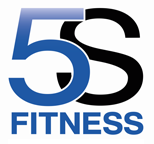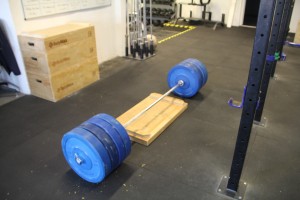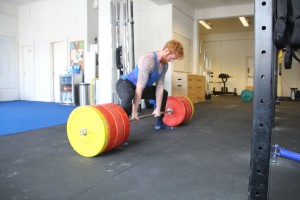It’s no secret that everyone wants a monstrous, earth shattering deadlift. Not only because it works just about every muscle in your body and can build a thick, muscular back that can’t be hidden by any jumper (edit: pullover/sweater for Americans) but because of the performance benefits that go with it.
The deadlift builds an insane rate force development (RFD). The ability to generate force through an initial concentric only movement, without relying on the eccentric phase and a stretch reflex to help you, can do wonders for explosive performance. Regardless of whether the athlete in question grinds through their sticking point or blasts through it with the full force of a ballistic missile, if both are lifting a heavy weight from the floor then both athletes have the capacity to display immense force rather quickly.
Now it is no secret that a strong athlete isn’t necessarily an explosive athlete. The ability to exert maximal force on an object and the ability to exert maximal force on an object QUICKLY are two very different things. Which is why speed deadlifts are very common in powerlifting circles, whether they are used in a typical westside style template or not.
Now conjugate training is basically a system where you combine the methods outlined in Vladimir M. Zatsiorsky’s Science and Practice of Strength Training:
Maximal Effort – Lifting a maximum load (90% +).
Repeated Effort – Lifting a non-maximal load to failure.
Dynamic Effort – Lifting a nonmaximal load with the highest attainable speed.
The conjugate system, also known as the westside system due to its mass popularisation and possible perfection by Louie Simmons, is highly effective IF programmed correctly with an adherence to YOUR own weaknesses. However this is not a talk about westside per say, this is a talk on how you can incorporate the deadlift into your workouts in the conjugate style.
Maximal Effort Method: Maximal effort lifting produces the biggest gains in strength but also drains the CNS the fastest. Without careful exercise selection and rotation the deadlift is by far the most brutal of lifts due to the heavy loads lifted, motor neurons recruited, lack of eccentric phase and often a psychological drain that accompanies getting fired up for a big lift.
What do I mean by exercise selection and rotation?
Simply choosing exercises that correspond with your weaknesses and changing them around every max effort session. Identify where you are weak in the deadlift, is it grip strength? Lockout? Breaking the bar off the floor? Do you stall around the knee?
Changing the max effort exercise around will help keep you from burning your CNS out. You can’t lift as much on a regular deadlift as what you can a snatch grip deadlift. It is working the same deadlift pattern, while potentially developing your weak points in the main lift if you identified them correctly. Regardless of where you are weak, if you get stronger on a snatch deadlift or a deficit deadlift I can guarantee 9 times out of 10 your normal deadlift will have gone up too. It is ideal to rotate the max effort exercise every session to avoid draining yourself and keeping your training morale high by trying to break new PB’s in each lift or at least come to within 90% of them.
Repeated Effort Method: This is the least stressful of Zatsiorsky’s recommendations and is ideally used for our accessory exercises but can also be used to good effect on our main lifts. However, the distinction to be made is between going to failure on the accessory work and not going to our failure on the main lifts. A simple example of this for the deadlift would be going to failure on GHD hyperextensions to build up the hamstrings but not going to failure on a deadlift back down set. Despite not working maximally, the loads lifted on the deadlift just like the squat and bench press are still very high. While going to failure in bodybuilding can be seen as a good thing in terms of hypertrophy and maximum muscular development, it is rarely seen as a good move when trying to drive up your main lifts due form breakdown and a higher increased chance of injury.
Repeated effort on the main lifts would be in the form of back down sets often prescribed to help build more volume. Accessory work is usually single joint work, such as leg curls to build up hamstrings but can also be multi joint work, such as RDL’s to strengthen the whole deadlift pattern.
Dynamic Effort: Speed Kills! Lifting a submaximal weight with maximum force with accommodating resistance in the form of bands and chains has done wonders to skyrocket peoples totals. Likewise, many powerlifters out there find it ‘useless’ and just ‘good theory’. Like many of the principles of conjugate training or the westside method, it is often misunderstood, miscarried out or the program is defeated before even being tried out (abandoning the program after a month or two). I am going to cover the dynamic effort method in more detail in a separate part of the article, however the basic lay out of dynamic effort training is:
- Submaximal weight (40-60% of 1 RM)
- Maximal acceleration (Bar speed 0.6 – 0.8 m/s)
- Short rest periods (40 Seconds to a Minute)
- Low reps, high volume (Kept in check usually with A.S Prilepin’s chart)
- Accommodating resistance (Chains that make up 25%+ of the weight and/or bands with the tension calculated)
That’s the first part of deadlifting in a conjugate style method covered. In part 2 I’ll address weak points in the deadlift and exercise variations to help them, part 3 will be the repeated or submaximal effort exercises that you can use to help develop the main lifts and the part 4 will be devoted to dynamic effort method as applied to the king of barbell lifts.



